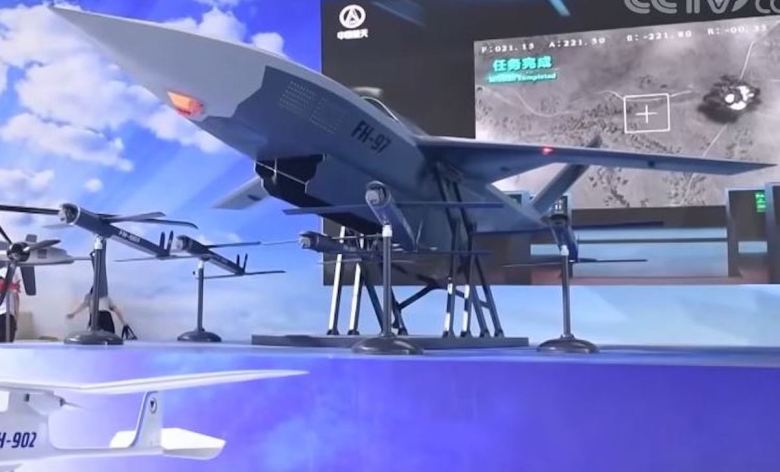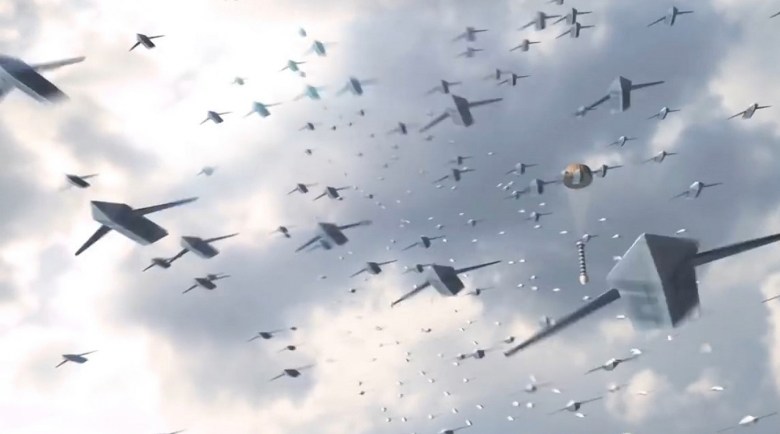beijingwalker
ELITE MEMBER

- Joined
- Nov 4, 2011
- Messages
- 65,191
- Reaction score
- -55
- Country
- Location
China speeding into the low-cost drone swarm lead
Jet engine innovation gives China yet another cost-competitive edge over US as both rivals see drone swarms as the future of warBy GABRIEL HONRADA
NOVEMBER 6, 2023

China has a growing cost-advantage over the US in fielding drone swarms. Image: Asia Times Files / iStock
China has developed a low-cost drone jet engine that could pave the way for the production of cutting-edge, cost-efficient drones, setting a precedent that could redefine global drone warfare strategies.
South China Morning Post (SCMP) reported that a new generation of high-speed, long-endurance drones powered by low-cost jet engines has entered military service in China, according to a lead scientist on the project.
SCMP says that the new Chinese drones stand out from other models due to the low cost of their power source and that the innovation could ignite a drone arms race as the US begins its program to ramp up the weapon’s production.
SCMP says that the technological breakthrough will allow the People’s Liberation Army (PLA) to source superior-performance jet drone engines at less than a fifth of the international price. The report says that the Chinese Academy of Sciences released a presentation on the project on October 19.
At the event, engineering thermal physicist Zhu Junqiang claimed the PLA has been quick to embrace the new engine, mainly because it consumes nearly a third less fuel than the current two-shaft engines in use and because maintenance costs will be significantly cheaper due to having 70% fewer mechanical components.

China’s FH-97 drone. Image: Chinese state media
In contrast, SCMP notes that a high-speed military drone powered by a jet engine is usually categorized as a high-value asset, but due to high costs they are stockpiled in small numbers in most military arsenals. The Northrop Grumman-made RQ-4 Global Hawk drone, for instance, is powered by an AE3007 turbofan engine supplied by Rolls-Royce at a cool US$4 million per unit.
SCMP says that even the US, which has a bigger military budget than all other global countries combined, can only currently afford 42 Global Hawks, which cost around $130 million each.
Future conflicts will likely become drone wars of attrition, with the Ukraine war illustrating the new-age warfare possibility. In an April 2023 article in the peer-reviewed Defense and Security Analysis journal, Marc DeVore states that the ongoing war has shown the virtues of low costs and expendability in drone warfare.
DeVore says that Russia lost at least 148 reusable drones and Ukraine 40 during the first nine months of the war, pointing out that the reasons for high drone losses are technical, as drone data links are susceptible to jamming. He says the weapons fly at lower and medium altitudes, also making them vulnerable to short-range air defenses.
He notes that both Russia and Ukraine have used drones for missions in densely defended zones, leading to a shift towards lower cost and more disposable platforms. For instance, he notes that Ukraine’s Turkey-made Bayraktar TB-2 and Russian Forpost and Orion are respectively their most sophisticated drones.
Still, he says their vulnerability has limited their effectiveness against jamming and low-altitude air defense assets. As a result, he says both countries have increasingly turned to very low-cost or disposable drones, as the cost of shooting down these one-way attack weapons exceeds their value.
Cognizant of this battlefield lesson, the US has initiated programs to mass-produce drones for a high-tech war of attrition.
In September, Asia Times reported on the US Replicator program, which aims to field massive numbers of AI-driven autonomous drones to counter China’s growing military capabilities. The program aims to rapidly advance the fielding of attritable autonomous platforms in air, land, and sea domains, with an aggressive 18 to 24-month deployment timeline.
The Pentagon’s Defense Innovation Unit will oversee the project while working with defense and non-traditional tech companies. Advancements in artificial intelligence, mesh networks and grand networking capabilities will facilitate autonomous, decentralized functioning, offering quicker deployment closer to the tactical edge.
Furthermore, in February 2023, Asia Times reported on the US “Autonomous Multi-Domain Adaptive Swarms-of-Swarms” (AMASS) project to develop autonomous drone swarms capable of being launched from sea, air and land to overwhelm enemy air defenses.
The project aims to develop the capability to launch and command thousands of autonomous drones, working together to destroy an enemy’s defenses, including air defenses, artillery pieces, missile launchers, and intelligence, surveillance and reconnaissance (ISR) platforms.
The AMASS program is expected to focus specifically on deterring or defeating a Chinese invasion of Taiwan. The program explores using “swarm-of-swarms” to conduct military operations with low-cost drones with diverse sensors and kinetic and non-kinetic effectors in highly contested environments,
Still, the US faces significant challenges in scaling up its low-cost drone production. A CNBC report last month noted that the problem with producing small consumer drones such as quadcopters in the US is that the price goes up since material and labor costs are higher than in China.
CNBC notes that many Western drone companies dropped out of the market in 2016 and 2017 due to being out-competed by China or because of bad business decisions. It also notes that making drones with parts solely sourced from the US is complicated, as the US does not have the factories to produce expendable military drones on such a massive scale. Nor does it have the secure supply chains needed to make sensitive components, the report said.

Future wars will be fought using drone swarms. Credit: C4ISRNET
China, on the other hand, is better-placed to ramp up low-cost drone production. China is currently already the world’s largest exporter of armed military drones; Shenzhen-based DJI commands 70% of the world’s consumer drone market.
Asia Times reported in September on China’s Sunflower-200 loitering munition, which is purportedly modeled after the Iranian Shahed-136, the weapon Russia is using in the ongoing Ukraine war that it has extensively modified to suit the specific battlefield conditions in the area. The drone was shown during the Army-2023 defense exhibition in Moscow.
Despite China having the capability to mass-produce the Sunflower-200 and improved versions for Russia, it has taken a cautious approach to its support for Moscow’s war effort, balancing its interests to ensure an outcome favorable to its interests while avoiding Western sanctions.
While it is unlikely that the Sunflower-200 will soon appear in Russia’s arsenal, China has sent dual-use drones to Russia cognizant they will be used for military purposes.

China speeding into the low-cost drone swarm lead
China has developed a low-cost drone jet engine that could pave the way for the production of cutting-edge, cost-efficient drones, setting a precedent
 asiatimes.com
asiatimes.com
